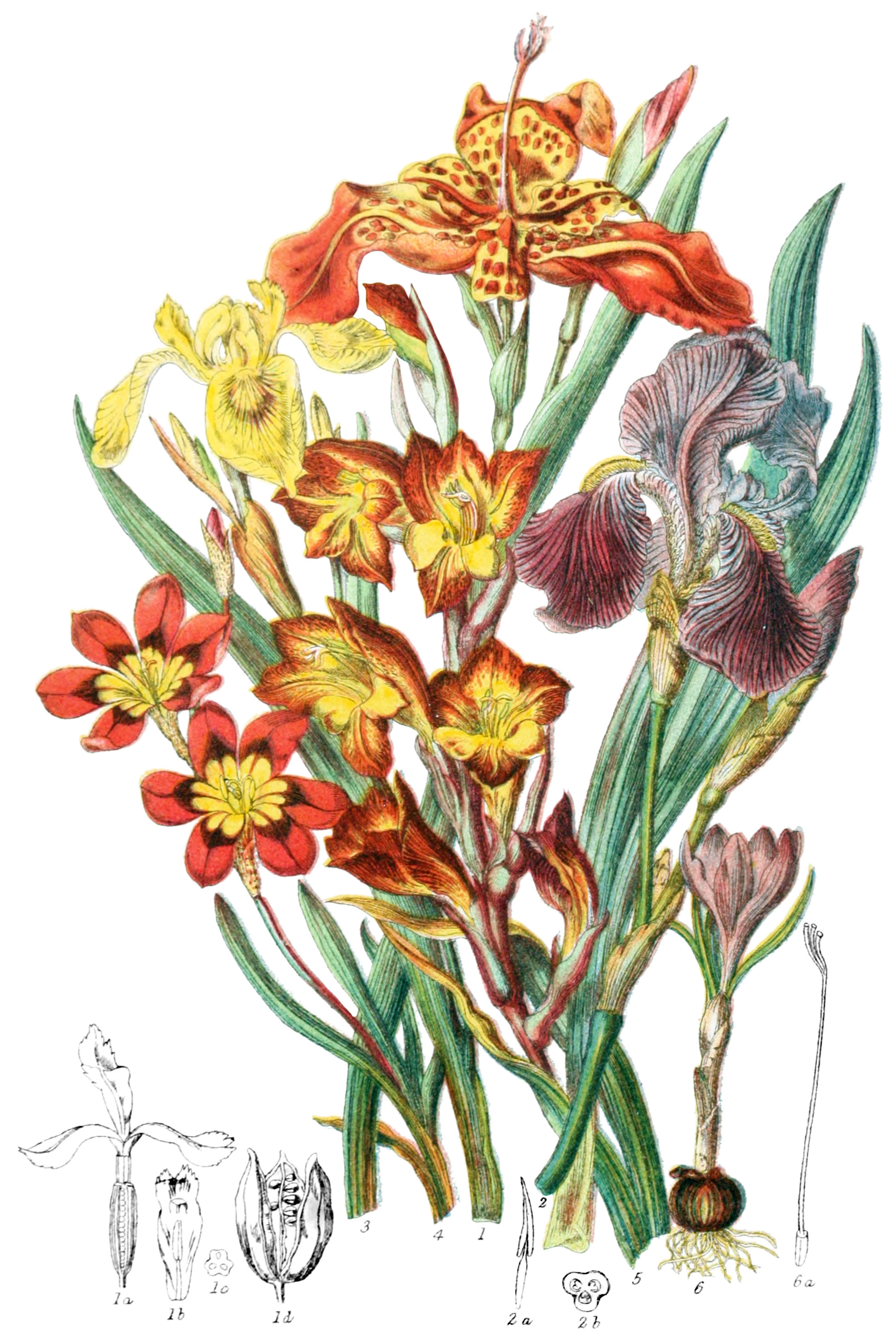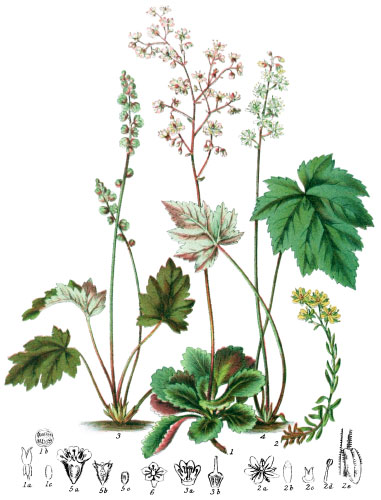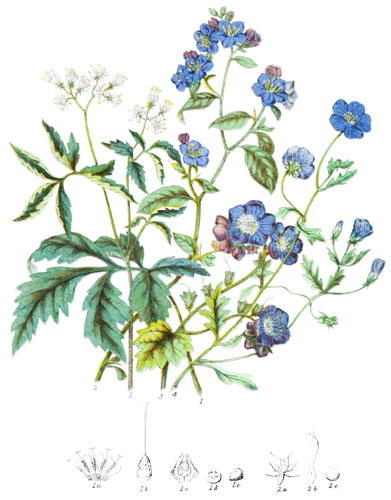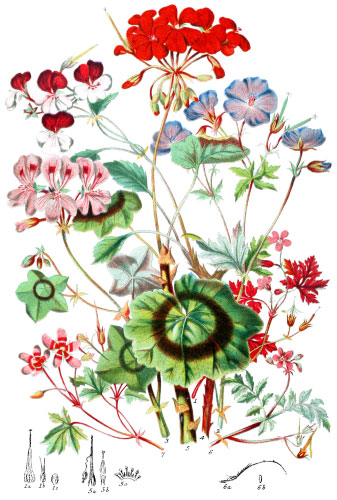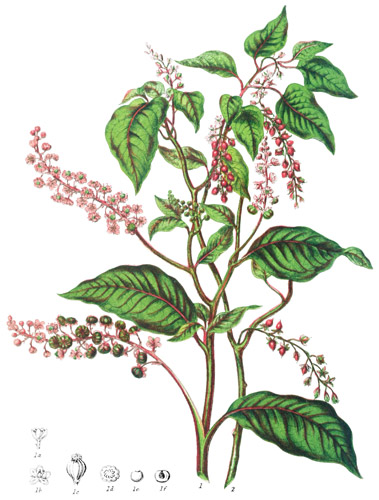Key characteristics
Herbaceous plants and a few undershrubs, usually smooth; the hairs, if present, are simple. The roots are tuberous or fibrous; the leaves grow one over the other. The flowers grow either directly from the root, or on terminal spikes, panicles or clusters. The bracts are sheathing, and sometimes membranous. The calyx is usually coloured, sometimes herbaceous; the three sepals and three petals are adherent, partially cohering or entirely separate, sometimes irregular. The petals are very short. The stamens arise from the base of the petals, the filaments are either distinct or united; the anthers are two-celled, burst lengthwise, and are fixed by their base. The ovary is three-celled, many-seeded, the style single with three stigmas, often of a petal-like nature, and sometimes two-lipped. The capsule is three-celled, and three-valved, gaping when ripe. The seeds are attached to the inner angle of the cells, and sometimes to a column becoming loose. They are round, angular, oblong or winged, and contain horny or densely fleshy albumen.
This Tribe has affinity with Amaryllidaceæ and Hæmodoraceæ, but differs in the number and position of the stamens.
Slightly stimulating properties exist in the roots of some species, and in the stigmas of Crocus.
Select plants in this order
Not all plants listed are illustrated and not all plants illustrated are listed.
- Iris was the name given by Theophrastus and other ancient writers to the beautiful genus which abounds in Southern Europe and the Levant, and was selected by modern botanists to be the type of a Natural Order.
- I. pseudacorus (1), although of less varied hues than some of the foreign species, is nevertheless a very graceful plant, and the pure yellow flowers arising plentifully amidst the tall sword-shaped leaves on the edges of streams have a charming effect. The dried and powdered root is used as snuff in the islands and poor districts of Scotland, and, being astringent, is frequently employed also in making ink, and dyeing black: the fresh juice of the rood is medicinal.
- I. germanica (2) possesses similar qualities; it was the first foreign Iris imported into our gardens, as early as 1573, and still remains a constant and favourite inhabitant of the flower-border.
- The roots of I. florentina are brought in a dry state from Leghorn, and sold as Orris-root; their sweet scent was formerly valued in the manufacture of hair-powder.
- Tigridia pavonia (3) is an extremely brilliant but ephemeral flower, enduring only for a day; the chief peculiarity of its structure is the long tube formed by the united filaments of the stamens at the top; the three anthers surround the triple stigma. Although a native of the hot climate of Mexico, the Tiger-flower flourishes well in the open air here, if placed in a sheltered and sunny situation.
- T. conchiflora belongs also to Mexico; the petals are of a deep yellow colour.
- Sparaxis tricolor (4) is one of the numerous beautiful bulbous-rooted plants of the Cape of Good Hope; the Greek name alludes to the torn spathes of the flower.
- Among the most striking of these flowers may be classed Gladiolus, so named from the Latin, on account of the sword-shaped leaves, though this is common to other plants of the Tribe.
- G. communis and G. segetum adorn the fields of South Europe.
- G. byzantinum is a native of Turkey; the rest all belong to the Cape, and are more or less ornament.
- G. psittacina (5) is a brilliant example of the Flora of Natal, of noble form, and harmonious in colouring.
- But the most beautiful plant must be considered the lowly Crocus (6), which is not only the chief embellishment of gardens in the earliest spring, but is valuable for the suply of Saffron obtained from the large stigmas of C. sativus. When the Saffron Crocus was first introduced in the reign of Edward III., it was extensively grown around Saffron Walden, in Essex, but its use, and consequently its cultivation, are much diminished. The colouring ingredient of Saffron has the peculiar quality of total dispersion by the sun. The starchy tubers of some of the Cape plants are said to afford food to the Hottentots; and the roasted seeds of Iris pseudacorus* may be a substitute for coffee.
- Ixia, Moræa, Sisyrinchium, and other genera, have been contributed to European gardens from the Cape, whose dry sands are the grand store of the most delicate and brilliant flowered bulbous plants in the great class of monocotyledons.
Locations
This Tribe is most abundant in South Africa, and in the central regions of North America and of Europe. A few species only are natives of the Tropics; few also are found in South America. Crocus belongs entirely to Europe and Asia; the African and Australian species are not known in America.
Legend
- Iris pseudacorus,* Yellow Water-Iris. England.
- Pistil and Ovary.
- Stamen and Pistil.
- Section of Ovary.
- Capsule.
- Iris germanica. German Iris. Germany.
- Stamen.
- Section of Ovary.
- Tigridia pavonia, Tiger Flower. Mexico.
- Sparaxis tricolor. Cape of Good Hope.
- Gladiolus psittacina. Natal.
- Crocus vernus, Spring Crocus. England.
- Style and Stigma.
*Iris pseudacrous was spelled “Iris pseudo-acorus” in the original description.
Explore more
Posters
Decorate your walls with colorful detailed posters based on Elizabeth Twining’s beautiful two-volume set from 1868.
Puzzles
Challenge yourself or someone else to assemble a puzzle of all 160 botanical illustrations.
